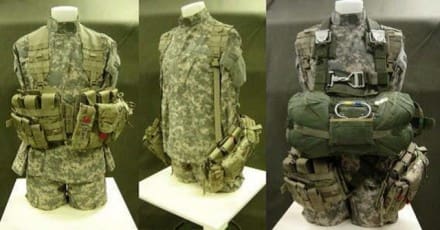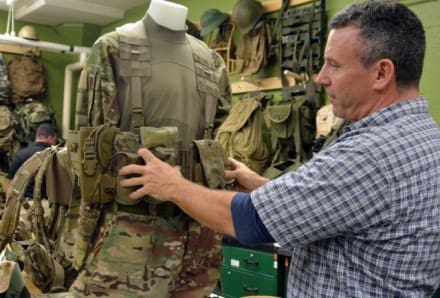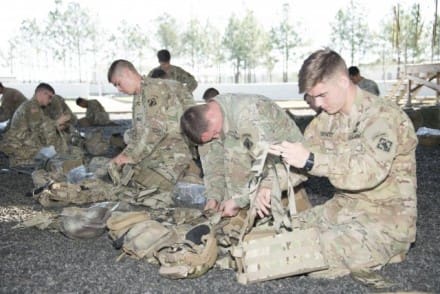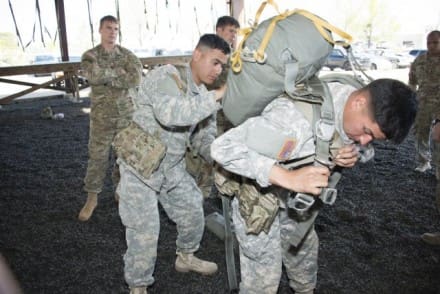
The Airborne Tactical Assault Panel (ABN-TAP) rigging configurations. (Photo Credit: Photo courtesy of PEO Soldier)
Fort Bragg, North Carolina — For the first time since their inception, Army Airborne forces will soon be fielding a new fighting load system tailored to the paratrooper’s unique requirements.
“The Airborne Tactical Assault Panel (ABN-TAP) was developed with the paratrooper in mind and will allow the paratrooper a greater degree of comfort, mobility and safety during static line airborne infiltration operations,” said Rich Landry of the U.S. Army Soldier Systems Center laboratories in Natick, Massachusetts.

Rich Landry of the U.S. Army Soldier Systems Center laboratories in Natick, Massachusetts, demonstrates key design features included in the Airborne Tactical Assault Panel (ABN-TAP) based on Soldier input. (Photo Credit: Photo courtesy of Natick Research laboratories)
Typical Airborne troops say the legacy load carrier systems have some drawbacks.
Previous designs must be worn under the T-11 parachute harness, which is less than optimal because it does not allow for a proper fit of the main parachute harness, and moves the T-11 reserve activation handle further away from the paratrooper’s grasp.
ABN-TAP enables Soldiers to rig the fighting load under the parachute harness but below the reserve parachute.

Soldiers from the 57th Sapper Company, 27th Engineer Battalion, 20th Engineer Brigade, assemble the Airborne Tactical Assault Panel (ABN-TAP) during New Equipment Training at Fort Bragg, North Carolina, before putting it through operational testing. (Photo Credit: Jim Finney, Combined Technical Services, Airborne and Special Operations Test Directorate, U.S. Army Operational Test Command)
“This will allow paratroopers to properly adjust the T-11 parachute harness to their specific sizing requirements and keep the T-11 reserve parachute handle well within reach,” said Sgt. 1st Class Ian Seymour, Test NCO from the Airborne and Special Operations Test Directorate (ABNSOTD) here.
The ABN-TAP design actually draws its lineage from the older Load Bearing System (LBE) used with the T-10 and MC1-1 parachute systems by paratroopers for decades.
Soon after the Global War on Terror began, all branches of the armed services rushed to modernize field equipment to meet the rigors of modern combat and allow for the constant presence of body armor, according to Mike Tracy, deputy test division chief at ABNSOTD.
“With the vest/plate carrier systems seeing overwhelming Soldier acceptance, the task of providing the paratrooper with a modern design compatible with current parachute systems is challenging to say the least,” Tracy said.

Paratroopers assigned to the 57th Sapper Company, 27th Engineer Battalion, 20th Engineer Brigade, Fort Bragg, N.C., practice “buddy rigging” the Airborne Tactical Assault Panel (ABN-TAP) at the 82nd Airborne Division Advanced Airborne School during New Equipment Training. (Photo Credit: Michael Zigmond, Audio Visual Production Specialist, Airborne and Special Operations Test Directorate, U.S. Army Operational Test Command)
The ABN-TAP bridges this gap by providing both new and old capabilities to the paratrooper.
Tracy explained that ABN-TAP allows not only for rigging under the parachute harness and reserve, but can be rapidly adjusted to serve as a “chest rig” design upon landing.
“Ground troops consider this to be the most efficient design under current operational conditions,” said Tracy.
“Operational testing using Airborne paratroopers, collects data which truly allows the Army to evaluate the suitability and safety of the ABN-TAP when worn during static line Airborne operations and follow-on missions,” Tracy said.
Before testing Soldiers participated in New Equipment Training (NET), which included familiarization with the system, fitting and proper rigging of the ABN-TAP with the T-11 parachute system.
Following NET, Soldiers conducted live parachute jumps from a C-17 high performance aircraft at 1,250 feet above ground level over Sicily Drop Zone here.
More senior Soldiers participating in testing were optimistic about the proposed rigging procedures.
“Having jumped the LBE system earlier in their careers, this proven rigging method signals a simple approach to a complex problem,” said Leon Price, senior ABNSOTD test officer.
“I think I benefitted personally by being a part of this,” said Spec. Aaron Adams, a Combat Engineer with the 57th Sapper Company, 27th Engineer Battalion, 20th Engineer Brigade. “I enjoyed participating in the testing because it allowed me to provide direct input into the test and I will get to see it once it is fielded to the Airborne force.”
“Any time Soldiers and their leaders get involved in operational testing, they have the opportunity to use, work with, and offer up their own suggestions on pieces of equipment that can impact development of systems that future Soldiers will use in combat,” said Col. Brad Mock, the director of all the Army’s Airborne testing.
Upon completion of testing, the ABN-TAP could potentially be issued to Army Airborne forces worldwide, signaling the first steps in modernizing the combat loads of thousands of paratroopers.
~~
The U.S. Army Operational Test Command is based at West Fort Hood, Texas, and its mission is about making sure that systems developed are effective in a Soldier’s hands and suitable for the environments in which Soldiers train and fight. Test units and their Soldiers provide feedback, by offering input to improve upon existing and future systems with which Soldiers will ultimately use to train and fight.
The Fort Bragg, North Carolina-based ABNSOTD plans, executes, and reports on operational tests and field experiments of Airborne and Special Operations Forces equipment, procedures, aerial delivery and air transportation systems in order to provide key operational data for the continued development and fielding of doctrine, systems or equipment to the Warfighter.
Tags: Natick


This looks promising. I hope it makes its way out the the rest of the troops ASAP.
Innovation is never a bad thing but paratroopers don’t spend but so many seconds to barely minutes under canopy and the rest of the time is on the ground as light infantry so developing specialized equipment to integrate with parachute harnesses that are ditched on landing doesn’t seem like a good investment. I’d reverse that and fix the harness to integrate with the gear.
The point is, paratroops have to have their battle gear on them when they hit the ground so that they are ready to fight the second they make contact.
This is just the Army buying stuff we were doing on our own already. We were setting up BlackHawk LBE’s like this in ’03.
I almost get goose bumps every time I see the 82nd troops ready to
Jump.It brings bring back old memories when I was with the 505 in 1963
To 65.Any thing that can give the troops an edge I am for it. I will always be an
(All American ) Go Panthers!
Great work! Well except that First-Spear released the JOKER rig in 2015 which is pretty much the same thing…
Innovation is only innovation if no one have been able to execute it before.
Looks like Natick is ripping off another vendor’s idea.
Again. Who owns the requirement? Where are the POM dollars coming from?
Try again. The concept of using a molle compatible system in a more traditional, lower riding LCE type set up didn’t first appear in 2015 with the Joker. Been happening since the day molle was first issued. Like the Joker this is an adaptation of what came before it.
It’s not just an low riding molle compatible LBE..
The Joker is basically a chestrig that you can drop into a low riding LBE with 2 SRBs- which is unique as far as I am aware.
DFLCS, 1.5 SRB’s instead of 1″. Matter of fact, look at the DFLCS and the First Spear Patrol Harness side by side. There is a connection with the old Eagle and First Spear though.
Issue Spear H harness, no SRB’s, but a similar concept from years before. So the Joker was possibly the first if we narrow it down to 1″ SRB’s. Bottom line is they brought some old concepts up to date and made it better.
You haven’t understood how the Joker and this rig works…
If you disconnect the SRBs on a DFLCS it will fall off your body. Here, and on the Joker, it simply drops the rig a bit lower. It’s still connected to your shoulder harness.
This is what makes the rigs jump friendly, because it allows you to have it sagging under your parachute while jumping, then once on the ground you simply engage 2 SRBs and it’s a chestrig.
DFLCS rigs DO NOT have this function.
I know exactly how they work. Do they function exactly the same, no. Like I said, old concepts brought up to date. You can adjust the length on all these in a few seconds, just in different ways. Like running the length out on your LCE and clipping in a front belt extender when you jump.
An a Ford Model 1 is the same as a Ferrari?
First-Spear came up with a NOVEL way of rapidly adjusting your CHESTRIG to fit under a harness, and more importantly; getting right back to where it was the second you have the harness off.
– And now Natick is testing the exact same concept.
That’s what I consider the (incremental) innovation here. Not carrying gear in molle pouches on a panel on your chest or waist…
Sure there’s already been ways to do this same thing, but this could get issued to every paratrooper in the formation and actually get put into the ASOPs. Two things none of the past solutions did. I’m looking forward to this capability enhancement (probably just in time for me to leave the airborne world.) And it beats cramming a TAP with full combat load into a MAWC.
In the first photos they show the new gear with an old T10R SLCP reserve. Looks more like an SF10A setup. To the best of my knowledge, the 82nd exclusively uses T11 and the T11 reserve. Curious as to why they weren’t showing that rig in the photos.
Well, I’m an old airborne Recon Marine and ” jumping” with 782 gear(LBE) was never a problem, even on HALO and HAHO jumps. On static line jumps your only in the saddle for a few seconds. Does it have to be this complicated?
Yes.
There was never an issue wearing the old belt and suspenders with a parachute harness, but we’ve found better ways to wear a fighting load over the years. This is merely a way to wear the improved load bearing the old way temporarily.
I know, right? If it worked in my time, it should work forever. Back in ’76, we fought his Britannic Majesty, King George, with a leather cartridge box on a long sling. Also, we saved money on ammunition, too, since we had muzzle loaders. When it takes 45 seconds & eleven steps to load a musket, you really appreciate aimed fire. And look at the shenanigans of the new standing Army, with their confounding “camouflage.” However does one even know who to shoot? We had blue wool coats; if you weren’t wearing blue (or were an Indian) we assaulted you most violently. Are these modern troops saying they know more than his excellency George Washington?!?
First off; TUBES! on issue gear. Speaks of good things to come.
Second: the whole rig (at least in the high position) being supported by a single dog-ear in 1″ webbing through a PALS slot gives me the willies.
Third: I love the use of wide webbing in lieu of fabric+foam+spacer, light, cheap and reasonably comfortable. I wonder why I never see this in OTS gear.
Disregard, on further inspection the dog ear appears to just be the tail tucked out of the way, but the height adjustment is a bit mysterious.
Great Info about new fighting load system for paratroopers.I recently read an article about this topic that,Airborne Tactical Assault Panel (ABN-TAP) is expected to allow soldiers to place the fighting load under the parachute harness but below the reserve parachute during airborne infiltration operations.It will allow paratroopers to properly adjust the T-11 parachute harness to their specific sizing requirements and keep the T-11 reserve parachute handle well within reach.